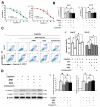Autophagy Induced by Areca Nut Extract Contributes to Decreasing Cisplatin Toxicity in Oral Squamous Cell Carcinoma Cells: Roles of Reactive Oxygen Species/AMPK Signaling
- PMID: 28257034
- PMCID: PMC5372540
- DOI: 10.3390/ijms18030524
Autophagy Induced by Areca Nut Extract Contributes to Decreasing Cisplatin Toxicity in Oral Squamous Cell Carcinoma Cells: Roles of Reactive Oxygen Species/AMPK Signaling
Abstract
Chewing areca nut is closely associated with oral squamous cell carcinoma (OSCC). The current study aimed to investigate potential associations between areca nut extract (ANE) and cisplatin toxicity in OSCC cells. OSCC cells (Cal-27 and Scc-9) viability and apoptosis were analyzed after treatment with ANE and/or cisplatin. The expressions of proteins associated with autophagy and the AMP-activated protein kinase (AMPK) signaling network were evaluated. We revealed that advanced OSCC patients with areca nut chewing habits presented higher LC3 expression and poorer prognosis. Reactive oxygen species (ROS)-mediated autophagy was induced after pro-longed treatment of ANE (six days, 3 μg). Cisplatin toxicity (IC50, 48 h) was decreased in OSCC cells after ANE treatment (six days, 3 μg). Cisplatin toxicity could be enhanced by reversed autophagy by pretreatment of 3-methyladenine (3-MA), N-acetyl-l-cysteine (NAC), or Compound C. Cleaved-Poly-(ADP-ribose) polymerase (cl-PARP) and cleaved-caspase 3 (cl-caspase 3) were downregulated in ANE-treated OSCC cells in the presence of cisplatin, which was also reversed by NAC and Compound C. Collectively, ANE could decrease cisplatin toxicity of OSCC by inducing autophagy, which involves the ROS and AMPK/mTOR signaling pathway.
Keywords: AMPK/mTOR signaling; areca nut extracts; autophagy; cisplatin; oral squamous cell carcinoma; reactive oxygen species.
Conflict of interest statement
The authors declare no conflict of interest.
Figures








References
-
- Gibson M.K., Li Y., Murphy B., Hussain M.H., DeConti R.C., Ensley J., Forastiere A.A., Eastern Cooperative Oncology Group Randomized phase III evaluation of cisplatin plus fluorouracil versus cisplatin plus paclitaxel in advanced head and neck cancer (E1395): An intergroup trial of the Eastern Cooperative Oncology Group. J. Clin. Oncol. 2005;23:3562–3567. doi: 10.1200/JCO.2005.01.057. - DOI - PubMed
MeSH terms
Substances
LinkOut - more resources
Full Text Sources
Other Literature Sources
Research Materials
Miscellaneous

